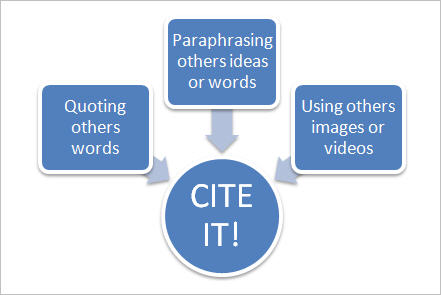Citation Help
Introduction to Citation
When you use information from articles, books, or websites to support your ideas, you must credit the original authors of these sources by citing them. A citation is a formal way to give credit and to provide readers with information about the sources you used. Citations state where you found the information so that others can find the original source for themselves.
There are a number of different styles or formats for citations. Which style you use depends upon the subject discipline and your professor's preference. The two most common citation styles are MLA (Modern Language Association) and APA (American Psychological Association). MLA is used primarily for English courses and APA is used for education, social sciences, and nursing courses. If you are uncertain about which style to use, ask your professor.
Each citation style includes the same basic elements - the author's name, source title, and publication information - but differs in the organization and presentation of these elements. For example, some citation styles use footnotes, while others use parenthetical citations. Some citation styles include the date of publication in in-text citations, while others reserve this information for the References, Works Cited, or Bibliography page.
For more information about the different citation styles, check the resources listed below.
Four Reasons to Cite Your Sources
1. Giving credit where it is due is the right thing to do.
2. Citing sources strengthens your position by showing you have consulted the experts.
3. Citations help interested readers find more information about your topic.
4. Effective use of citations will help you avoid plagiarism.
For more information on why we cite, please watch the video below.
Any time you include outside information in your paper, things that are not your personal opinion or experience, stop and ask yourself if you need to be citing your source in the text of your paper. If the information is common knowledge, something everyone knows, then you don't need to cite it. For instance, if you say "The Big Bang theory posits that the universe began billions of years ago with an enormous explosion," you do not need to identify where you obtained that bit of information.
If, however, you include obscure or unique details or talk about someone else's ideas or opinions, you must give credit.
If you use an author's exact wording, you must place it in quotes and cite it within the body of your paper.
Each citation style has a different way of incorporating source information, but at the very least you will need to provide the author's name and the page number where the quote or idea was found.

Source: Oviatt Library
Plagiarism at CSCC
Plagiarism, cheating, and other forms of academic dishonesty are prohibited. Students involved in academic misconduct, either directly or indirectly through participation or assistance, are immediately responsible to the instructor of the class. In addition to other disciplinary sanctions which may be imposed through the regular institutional procedures as a result of academic misconduct, the instructor has the authority to assign an “F” or a zero for the exercise or examination, or to assign an “F” in the course. Cleveland State Policy 3:02:00:01
Plagiarism is presenting the words or ideas of someone else as your own without proper acknowledgment of the source. If you do not credit the author, you are committing a type of theft called plagiarism. When you work on a research paper, you will probably find supporting material for your paper from works by others. It's okay to use the ideas of other people to bolster your own, but you must correctly credit them. When you quote, summarize, or paraphrase information found in books, articles, or on websites, you must acknowledge the original author.
It is plagiarism when you
- Buy or use a term paper written by someone else.
- Cut and paste passages from a website, book, or an article and insert them into your paper without citing them. (It is very easy for your instructors to search and find passages that have been copied from the web.)
- Use the words or ideas of another person without citing them.
Plagiarism: How To Avoid It
- Use your own ideas. Your ideas should be the focus of your paper.
- Use the ideas of others sparingly--only to support or reinforce your own argument.
- When taking notes, include complete citation information for each item you use.
- Use quotation marks when quoting another person's work.
- Take 30 minutes and write a short draft of your paper without using any notes. It will help you think through what you want to say and prevent you from being too dependent upon your sources.
The video below will explain more about how to avoid plagiarism.